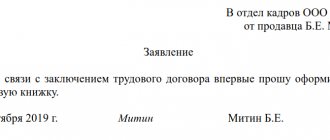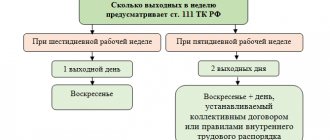Home / Labor Law / Payment and benefits / Wages
Back
Published: 03/03/2016
Reading time: 9 min
0
5964
The organization of remuneration is an important element of the work of any enterprise, and each of them has its own approaches to solving this issue. The choice of one or another remuneration system depends on many factors: the field in which the company operates, the specifics of its activities, the number of employees, etc.
The characteristics of existing payment systems (tariff and non-tariff), as well as their advantages and disadvantages, will be discussed further.
- What is a wage system
- Tariff system Main elements Tariff rate
- Salary
- Tariff coefficient
- Tariff schedule
- Floating salary system
Compensation and wages
The Labor Code of the Russian Federation in Article 129 synonymizes the concepts of “remuneration” and “wages” and defines them as a set of three elements:
| 1. remuneration for work | main (mandatory) part |
| 2. compensation | |
| 3. incentive payments | additional part |
Are compensation and incentive payments taken into account when paying for work on days off and non-working holidays ?
However, it is worth considering that not all components are required to be paid to the employee.
Monthly earnings cannot be lower than the minimum wage level established by the Government, and includes allowances for the complexity of the work and special conditions (work on weekends, etc.). But incentives remain at the discretion of the employer and are awarded only if the employee has done his job well, in the opinion of the employer.
As a result, it turns out that the concept of remuneration is broader than the concept of wages, because is a list of all the elements from which the wages of a particular employee are subsequently collected.
Each employer decides independently how to pay wages, taking into account the minimum provisions of the Labor Code.
Is labor legislation violated if employees are paid less than the minimum wage and are also paid a monthly bonus ?
Art. Art. 23 and 132 of the Labor Code establish the impossibility of discrimination against workers with equal qualifications, output and quality of work. This means that you cannot set different pay for the same work.
Accordingly, the employer must apply uniform parameters when setting wages. A variation of such parameters represents a remuneration system. It must be based on legal norms and not worsen the employee’s position in comparison with them.
TARIFF AND FREE-TARIF SYSTEMS
The tariff system allows us to compare various types of work, taking into account their complexity and conditions of implementation.
When organizing the remuneration of workers, the main elements of the tariff system are tariff and qualification reference books, tariff schedules and rates.
The tariff and qualification directory contains a list of industries and professions in industries with characteristics of each profession. Using the directory, the content and level of work and the requirements for its performer are determined.
The tariff schedule is a set of existing tariff categories and the corresponding tariff coefficients.
The tariff coefficient shows how many times the level of payment for work of a given category is higher than the level of payment for work of the first category.
The tariff rate is the absolute amount of wages expressed in monetary terms per unit of working time. Tariff rates can be hourly, daily and monthly. The tariff rate of category I cannot be lower than the minimum wage established by the state.
The Government of the Russian Federation has approved the Unified Tariff System (UTS) for institutions and organizations of the public sector. Outside the budgetary sphere, organizations and firms use different sizes of the range of employee categories.
Tariff coefficients of the Unified tariff schedule for remuneration of employees of public sector organizations
| Indicators | |||||||||
| Rank | |||||||||
| Tariff coefficients | 1,0 | 1,36 | 1,69 | 1,91 | 2,16 | 2,44 | 2,76 | 3,12 | 3,53 |
| Rank | |||||||||
| Tariff coefficients | 3,99 | 4,51 | 5,10 | 5,76 | 6,51 | 7,36 | 8,17 | 9,07 | 10,07 |
An example of a tariff schedule for enterprise workers
| Indicators | Rank | |||||||
| Tariff coefficients | 1,0 | 1,09 | 1,21 | 1,33 | 1,50 | 1,71 | 1,98 | 2,34 |
Recently, a number of enterprises have used a tariff-free wage system. Under this system, the wages of all employees represent a share in the wage fund of either the entire enterprise or a separate division.
The most common method of calculating wages is in which the actual amount of earnings of each employee depends on the employee’s qualification level, the labor participation rate (LPR), and the actual time worked.
Another method of determining wages using a non-tariff system is that wages depend on sales volumes. For example, the director of an enterprise is paid 1.5% of the sales amount, his deputies - 80% of the director’s salary, and so on in accordance with the qualification level.
A type of non-tariff system is also a contract system, when a contract is concluded with an employee for a certain time, indicating the level of payment.
WAGES AND LABOR PRODUCTIVITY
Policy in the field of wages is an integral part of enterprise management, and the efficiency of its work largely depends on it, since wages are one of the most important tools for rational use of labor. When developing wage policy, it is necessary to take into account the relationship between wage growth and labor productivity.
Three main models can be distinguished that determine the relationship between the growth rates of labor productivity and wages (Fig. 16):
· wage growth is proportional to labor productivity growth;
· wage growth lags behind wage growth (degressive model);
· wage growth outstrips labor productivity growth (progressive model).
Rice. 16 Ratio of wage growth and labor productivity
The first model (Fig. 16, I) can be considered ideal. On a state scale, it does not generate inflation, but provides an incentive for an enterprise to increase the productivity of its employees. In practice, this ratio is difficult to maintain.
The second situation (Fig. 16, II) should not generate inflation, but does not contain an incentive to increase labor productivity.
If the rate of wage growth exceeds the rate of growth of labor productivity, then this model stimulates the growth of labor productivity, but generates inflation (Fig. 16,III). Too high rates of wage growth (Fig. 16, IV) disrupt the relationship between labor costs and remuneration, which also leads to a decrease in labor productivity.
Thus, a competent policy in the field of remuneration makes it possible to increase its productivity, and, consequently, the efficiency of the use of labor.
TOPIC 6. ENTERPRISE COSTS
In the process of the main activity of the enterprise, the resources available to it are consumed. The result of this activity is a product, the production costs of which reflect the level of resource use. If the total costs (expenses) are lower than the income from sales of the enterprise's products, it has a positive result of its activities, called profit.
TYPES OF COSTS
Costs are the monetary expression of the costs of production factors necessary for an enterprise to carry out its production activities.
In countries with developed market relations, there are two approaches to estimating costs: accounting and economic.
Accounting costs represent the cost of resources expended, measured in actual acquisition prices. These are costs presented in the form of payments for purchased resources (raw materials, materials, depreciation, labor, etc.).
However, to make decisions about whether to continue operating their business, owners must consider the economic costs.
Economic cost is the amount (cost) of other products that must be given up or sacrificed in order to obtain a certain amount of a given product.
The domestic economy is characterized by an accounting approach to cost estimation. If we take this into account, the terms “costs” and “expenses” can be considered synonymous.
For accounting purposes, costs are classified according to various criteria.
By economic role in the production process
costs can be divided into basic and overhead.
The main ones include costs associated directly with the technological process, as well as with the maintenance and operation of labor tools.
Overheads – costs for maintenance and management of the production process, sales of finished products.
According to the method of attributing costs to the production of a specific product
distinguish direct and indirect costs.
Direct costs are costs associated with the production of only this type of product and attributable directly to the cost of this type of product.
Indirect costs in the presence of several types of products cannot be attributed directly to any of them and must be distributed indirectly.
In relation to the volume of production
costs are divided into variable and fixed.
Variable costs are costs, the total value of which for a given period of time is directly dependent on the volume of production and sales.
Fixed costs are understood as those costs, the amount of which in a given period of time does not directly depend on the volume and structure of production and sales.
Variables usually include costs of raw materials, fuel, energy, transport services, part of labor resources, i.e. those costs whose level changes with changes in production volume (Fig. 17 a).

However, if we consider average variable costs (costs per unit of production), we will notice that their level remains approximately the same for different production volumes. Approximately the same amount of raw materials, electricity, etc. is consumed per unit of production. (Fig. 17 b).
Fixed costs include deductions for depreciation, rent, salaries of management personnel and other costs that occur even if the enterprise does not produce products. In a certain range of output, the total amount of these costs remains practically unchanged (Fig. 18a).
As for average fixed costs (per unit of production), they decrease with increasing production volume and increase with its decrease (Fig. 18 b).

The sum of fixed and variable costs is the total costs of the enterprise. With an increase in the volume of production and sales of products, gross costs per unit of production are reduced due to a decrease in fixed costs.
BREAK-EVEN SCHEDULE
The division of costs into fixed and variable is the basis of a method that is widespread in economics. It was first proposed in 1930 by engineer Walter Rautenstrauch as a planning method known as the critical production schedule or break-even schedule (Fig. 19).
The break-even chart in its various modifications is widely used in modern economics. The undoubted advantage of this method is that with its help you can quickly obtain a fairly accurate forecast of the main performance indicators of an enterprise when market conditions change.
When constructing a break-even schedule, it is assumed that there are no changes in prices for raw materials and products during the period for which planning is carried out; fixed costs are considered constant over a limited range of sales volumes; variable costs per unit of output do not change as sales volume changes; sales are carried out quite evenly.
When plotting a graph, the horizontal axis shows production volume in units of products or as a percentage of production capacity utilization, and the vertical axis shows production costs and income. Costs are deferred and divided into fixed (POI) and variable (PI). In addition to the lines of fixed and variable costs, the graph displays gross costs (VI) and revenue from sales of products (VR).

The point of intersection of the revenue and gross cost lines represents the break-even point (K). This point is interesting because with the corresponding volume of production and sales (Vkr), the enterprise has neither profit nor loss. The production volume corresponding to the break-even point is called critical. When the production volume is less than critical, the enterprise cannot cover its costs with its revenue and, therefore, the result of its activities is losses. If the volume of production and sales exceeds the critical level, the enterprise makes a profit.
The break-even point can also be determined using the analytical method .
Revenue from product sales is determined by the expression
where is POI
– fixed costs;
PI –
variable costs;
P
– profit.
If we take into account that at the break-even point profit is zero, then the point of critical production volume can be found using the formula
Sales revenue is the product of sales volume and product price. The total amount of variable costs can be calculated as the product of variable costs per unit of production and the volume of production corresponding to sales volume. Since at the break-even point the volume of production (sales) is equal to the critical volume, the previous formula takes the following form:
where C
– unit price;
VPI
– variable costs per unit of production;
Vkr
– critical issue.
Now you can calculate the critical release:
Using break-even analysis, you can not only calculate the critical production volume, but also the volume at which the planned (target) profit can be obtained. This method allows you to choose the best option when comparing several technologies, etc.
The benefits of dividing costs into fixed and variable parts are used by many modern enterprises. Along with this, cost accounting at full cost and their corresponding grouping are widely used.
Forms of remuneration
Do not confuse the concepts of “payment system” and “form of payment” - they are not identical, although in the literature they replace each other.
A system is a set of rules for remuneration. Form is one of these rules.
Art. 131 of the Labor Code of the Russian Federation establishes two forms in which labor can be paid:
- Cash – made in rubles.
- Non-monetary - in kind - paid in any material or immaterial form not prohibited by law. The size of the natural part is no more than 15% of the person’s entire salary.
How to reflect in accounting the remuneration of an employee in kind (with the organization’s own products)?
How is work structured according to the tariff?
The tariff system for calculating wages is discussed in Art. 143 Labor Code of the Russian Federation. It assumes that salaries paid to employees are differentiated depending on the labor intensity of the work, the amount of knowledge and skills required, and the characteristics of employment conditions, including natural and climatic conditions.
The company independently develops payroll rules that do not contradict current legislation, professional standards, and industry agreements, and enshrines them in an internal act. The system is based on the fact that work of equal complexity should be paid equally (Article 132 of the Labor Code of the Russian Federation).
The tariff payment system is the only one named in the Labor Code. Initially, it was developed as a set of rules for calculating remuneration for public sector employees, specialists in hazardous industries, and workers in the Far North. Today it is widely used in state-owned companies, and its use in private firms avoids excessive control by the labor inspectorate.
Pay systems
The remuneration system is a documented “instruction” on how to calculate an employee’s salary for a specific period worked, containing a complete list of parameters for the accrual and deduction of funds.
The employer, depending on the nature of the business activity, can use wages to increase output and/or reduce costs. To do this, you need to choose rational remuneration systems.
How can an organization switch to a new remuneration system ?
There are 3 main systems, divided into many types. For clarity, they are all presented in the table below.
| 1. Tariff system | Time-based |
|
| Piecework |
| |
| 2. Tariff-free | ||
| 3. Mixed |
| |
System composition
The tariff system of remuneration includes all the fundamental components:
- coefficients and salaries;
- target salary schedule. It is understood as a complex of existing categories;
- rates.
In addition, TSOT involves calculation taking into account the following parameters:
- a unified tariff and qualification reference book (UTKS) for the tasks performed, as well as the professions of workers;
- state guarantees regarding the formation of salaries;
- ETKS for the positions of managers, employees, as well as specialists or professional standards.

Another immutable point is that when determining salaries for identical positions, its volume must be the same.
Tariff system of remuneration
Tariff SOT is the most common, used by both government agencies and commercial organizations. It is based on the ranking of employee salaries depending on their qualifications, work experience, acquired skills, output, conditions and nature of work. In government agencies, the Unified Tariff Schedule is used. In commercial ones - documents similar to it, approved taking into account the opinion of the trade union body.
Tariffing is regulated by law for many industries. For example, for employees in the education sector, an individual tariff SOT has been established in accordance with Government Decree No. 583 dated 05.08.2008.
There are two types of tariff systems: piecework and time-based.
Tariff system
This system is basic and is used in the practical activities of most enterprises. It is a set of standards by which wages for employees are determined depending on several factors:

- complexity of the work performed;
- qualification;
- work conditions;
- nature and intensity of work;
- types of production.
Distinctive features and features of this system are:
- taking into account the contribution made to the overall result by a specific employee;
- the presence of clearly established tariff rates or official salaries, which are due to employees depending on their professional qualities;
- the ability to take into account all deviations from normal working conditions and charge appropriate additional payments for this.
Essential elements
In accordance with Art. 143 of the Labor Code of the Russian Federation, the tariff system includes the following basic elements:
Tariff rate
It determines the amount of remuneration of an employee for a certain unit of time (hour, day, month), and also takes into account the degree of complexity of the work he performs. For example, category I is established for those workers who perform the simplest actions.
A further increase in the degree of complexity of the work leads to an increase in discharge.
Tariff rates are differentiated according to the following criteria:
- labor intensity;
- type of company financing (commercial, budget, mixed);
- degree of harmfulness of work (normal, heavy, harmful).
This indicator is expressed in monetary units.
Salary
With its help, the amount of payment is determined for those workers whose work cannot be regulated. Also, salaries are set for certain types of employees (managers, employees and specialists).
Tariff coefficient
An indicator characterizing how much the tariff rate of a certain category exceeds the rate of the first category (taken as one). For example, if the wages of a worker of the second category are three times higher than the rate established for the first, the tariff coefficient is taken equal to 3.
Tariff schedule
It looks like a table with tariff rates and coefficients included in it. With its help, you can determine what kind of increase in wages an employee with a certain rank can expect.
The number of categories and the type of tariff scale applied depend on the specific field of activity of the enterprise.
Advantages and disadvantages
The main advantages of using the tariff system are the following factors:

- It is possible to take into account the contribution of each employee to the amount of work performed and pay for it in accordance with the effort or time spent.
- When calculating wages, the manager does not need to set the amount himself; all rates and salaries are determined by law. Therefore, you can use these figures when calculating the salary of all employees.
- For work in certain areas of activity or if it is performed overtime, at night, or in the form of part-time work, this system establishes clear amounts of additional payments and compensation.
However, there are also disadvantages to its implementation:
- when paying for labor, little consideration is given to the quality of the work performed; only quantitative indicators (output, hours, working days) and employee characteristics (qualifications, position) are taken into account;
- very low opportunities are created for encouraging individual employees and their material motivation to improve their work;
- Tariff rates and salaries are low and must be set in accordance with various legislative acts, which requires good knowledge of them.
Varieties
The tariff system can be used for workers in all fields of activity - it is basic for budgetary and commercial organizations, for manufacturing enterprises and companies providing various services.
This is due to the fact that with its help it is easiest to establish the level of remuneration of an employee depending on his qualifications, experience, professionalism and time spent. The tariff system takes into account the results of the work of a particular employee and is also divided into several forms:

- Piecework – in this case, payment for an employee’s work is carried out on the basis of his actual output. This form is best used in cases where the employee’s work results can be easily assessed in quantitative terms (for example, sales volumes, number of parts manufactured or customers served, etc.).
- Time-based – this form involves paying an employee based on the time actually worked. It is used in cases where it is difficult to express the labor result in quantitative terms (this includes all office workers and administrative personnel).
Each of these forms is divided into its own subspecies. The choice of one form or another depends on the specifics of the activities of a particular company.
Time-based form of remuneration
Time-based SOT is used at those enterprises where there is no need or opportunity to normalize production. Employees' job functions do not include the production of goods or services, so it is optimal to pay wages for time, and not for the amount of work. Almost all administrative and economic personnel “sit” on this COT. Payment will be made based on the employee’s qualifications and actual time worked in the accounting period.
Peculiarities of salary calculation for different types of time-based wages
With a simple time-based wage, the time worked in the period is paid. Periods can be recognized as: hours, days, months and variations of these periods.
With a bonus , a bonus for the quality of work is added to the salary for time, calculated as a percentage of the salary at the rate. The bonus may be one-time or applied on an ongoing basis.
With a salary , the employee has the right to count on a monthly salary in the amount as established in the employment contract. Upon achieving a certain qualification (determined subjectively by the employer), the salary may be increased.
Time form
It is used when the labor of workers cannot be regulated or it is quite difficult to organize such accounting.

Often this form is used in relation to administrative and managerial staff; it is also used for service and support areas. It can also often be found in relation to part-time workers.
Piece wage system
Piece work is used by organizations that provide services, perform work, or produce goods. Their profit directly depends on the speed of their employees’ work, so it is profitable to pay not per unit of time, but per unit of output. The payment formula is as follows: as much as you did, you received as much. The quantity of the product is multiplied by the unit price (piece rate). Such SOT encourages employees to constantly improve their output and quality of work. The second indicator is no less important, because Salaries are calculated based on the results of the period strictly after analyzing the work. Those. if Petrov produces 200 parts, of which 100 are unusable, only 100 will be paid for.
The basis for calculating wages will be documents confirming that employees have fulfilled their personal production plan. In order to facilitate calculations and minimize errors, it is necessary to carefully consider the system for recording employee performance.
How labor is paid for different types of piecework wages
With direct payment, payment is made for the number of units of output at the same price for each.
With progressive - the piece rate increases for each unit above the plan.
With a bonus , a bonus is added to the salary calculated according to the direct piece-rate system for fulfilling the plan, compressing deadlines, absence of defects, economical material consumption, etc.
With indirect payment, the work of support staff is paid, the amount of payment is set as a percentage of the salary of the main employee.
With a lump sum salary, the salary is accrued for the comprehensive implementation of the plan in general; the unit of output in this case does not play a role. There are:
- individual piecework SOT - salary for achieving one’s own indicators;
- collective - the salary of one person depends on the successful achievement of goals by the entire team. This system develops team spirit in the team.
What is non-tariff wages?
This is the accrual of funds according to the qualities and qualifications of a specialist; it involves an individual approach to the calculation of wages for workers.
The peculiarity of the system lies in the absence of the use of tariff scales and salaries. However, coefficients are still used to indicate the effectiveness of each employee; this indicator is used in determining the employee’s share in the salary fund.
This system is necessary to stimulate the productivity of the enterprise, increase the level of work of specialists and achieve their goals.
You will learn how to develop the most effective wage system in this video:
The legislative framework
The entire process of remuneration for the work collective is described in Chapter 21 of the Labor Code of the Russian Federation - it specifies options for calculating funds and their transfer to workers, the issue of applying coefficients and other allowances.
Another important legislative act is Federal Law No. 82 on the minimum wage limit.
In 2021, this law was adjusted regarding the procedure for subtracting the minimum minimum wage for different regions.
Tariff and non-tariff systems - the main differences
Important: most enterprises prefer tariff wages as the basic one. You will learn what the tariff scale by category is in the article at the link.
It consists of a number of standards that are applicable in conjunction with factors and bases when calculating wages:
- The level of complexity of performing duties in this position;
- Qualification skills;
- Working conditions;
- Production category.
The differences between these two payment systems are as follows:
- Definition of contribution - with tariff payment there is no consideration of the employee’s individual efforts; here the priority is the achievements of the team;
- Calculation system - with a tariff system, rates, salaries, and coefficients are used in the calculation, which is not the case in a non-tariff system;
- Identification of all deviations - the tariff system involves the payment of bonuses for work in harmful and dangerous conditions;
- Accounting for employee efficiency – a tariff-free system is built on taking into account the productivity and efficiency of each individual. Here you will learn how to evaluate staff performance.
Important: in non-tariff wages, the coefficient is applied individually for each worker according to the effectiveness of his efforts, and not complex, as is the case with the tariff option, but it should be remembered that the payment cannot be lower than the minimum wage.
Advantages and disadvantages of tariff-free payment
The positive aspects of a tariff-free system are as follows:
- It makes it possible to pay an employee based on the size of the payroll; to do this, it is necessary to determine its size, and then, based on this, calculate the share of each individual;
- Such a system has a stimulating nature in itself, which ensures full dedication of employees and does not require the introduction of additional allowances;
- With the active growth of enterprise productivity, employees receive excellent benefits, since their salary directly depends on its income, and this contributes to self-realization;
- This system makes it possible to calculate salaries using simple calculations, which provides employees with the opportunity to independently determine their own monthly income;
- As a result of the application of a tariff-free system, each division self-organizes, since the enterprise’s income depends as much as possible on the error-free execution of all processes.

However, there are also disadvantages:
- Employees are monthly in the dark about their income; only the hope that payments will comply with the minimum wage can reassure them;
- When calculating salaries, the manager can take into account personal emotions regarding a particular employee;
- The use of such a system in large enterprises is quite difficult due to the complexity of calculating individual indicators;
- The calculation takes into account the qualifications and potential abilities of the employee, but does not take into account his contribution to the common cause.
Tariff-free wage system
The tariff-free SOP is similar to the option system in startups. There is a payroll and employees. Let’s assume 100 thousand rubles and 10 people. The employer establishes that:
- The payroll can be increased if the company’s profits rise,
- The share of each employee’s salary is 10%.
The share can rank employees by the amount of participation in work or be the same for everyone.
In the employment contract, of course, they will write down 10 thousand rubles - salary per month. It is impossible to mention % according to the Labor Code, and it is not very profitable for the company.
After the announcement of working conditions, there is no need to establish additional incentives; employees themselves will strive to increase the company’s income. This model is applicable to small, start-up companies that will not go public, but want to interest employees without having money for bonuses.
Tariff-free system
This system provides for payment of an employee not in accordance with his individual achievements, but on the basis of an assessment of the work of the entire team. Moreover, this can be either an enterprise as a whole or small groups, departments or teams within it. There is no fixed salary or tariff rate for the employee.
In a non-tariff system, each employee is assigned a separate labor participation coefficient (LFC), on the basis of which his salary is calculated. This coefficient is multiplied by the total wage fund established for the labor group, and thus the final wage is calculated.
The features of this system are:

- Lack of established salaries and tariff rates. Their size, the amount of bonuses and other payments, as well as the procedure for their distribution are determined by the management of the enterprise. They are fixed in the local regulations of the company.
- The size of the coefficient assigned to an employee depends on many factors: his education, work experience, qualifications, work skills, etc. This indicator can be either constant or variable (that is, after a certain period of time it is revised).
- The wage fund represents a certain percentage of the total revenue or profit that the enterprise receives.
The main advantage of the non-tariff system is the high level of motivation of employees and the formation of their interest in the overall results of the company (department, group, team).
Such a system allows you to protect wages from the influence of inflation and eliminates the need for constant revision of their size.
As for the disadvantages, the main one is the fact that this system will be effective only if all employees are interested in the work and fair calculation of coefficients. Another disadvantage is the instability of wages, which depends on the level of income (in the event of a crisis, it may decrease).
It is best to use this system in enterprises with a small number of employees or in those where it is possible to divide them into groups according to functional characteristics. A tariff-free system will be effective in enterprises with a group labor organization, in which the final result is important.
What to do if the employer does not pay wages? We have compiled effective instructions for you that will work on your boss. If you are faced with an annoying delay in your salary, then know that in addition to the due wages, you are also entitled to compensation. Read more in this article.
All useful and relevant information about piecework payment is here.
Mixed remuneration system
A mixed SOT combines tariff and non-tariff SOT - the employee has a certain salary, but in this case it directly depends on the success of his work: on the number of sales, on the quality of developments, on time worked, etc.
The more output, the higher the salary. And vice versa. The difference from the tariff is that the entire salary is reduced down to the minimum wage.
How are salaries calculated for different types of mixed labor protection?
The floating salary system involves recalculating salaries on a monthly basis based on the results of work for the previous period.
In commission calculations, an employee can count on a percentage of the company’s profit in general, or from each unit of output. This COT is very often used in insurance companies.
Payment for labor in a dealer network is very close to payment under a civil contract, but it also occurs in labor law. An employee is obliged to sell a certain amount of company goods, which he purchases at his own expense. The difference between the purchase price and the selling price to third parties is the person’s wages.
Remuneration without tariff
In addition to TSOT, there is also a tariff-free system for calculating workers' salaries. The non-tariff method is distinguished by the presence of a close connection between the salary and the corresponding fund. It is formed according to the pre-established labor results of the company.

The non-tariff system involves setting a constant salary coefficient for a worker according to his qualifications. It is worth noting that the non-tariff method takes into account the labor participation rate, which exists for everyone working in the organization.









